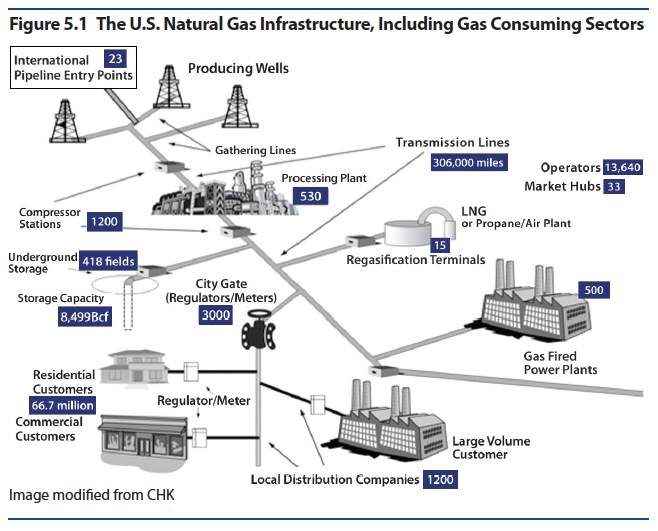MIT ENERGY INITIATIVE
Executive Summary
Natural gas has moved to the center of the current debate on energy, security and climate. This study examines the role of natural gas in a carbon-constrained world, with a time horizon out to mid-century.
The overarching conclusions are that:
- Abundant global natural gas resources imply greatly expanded natural gas use, with especially large growth in electricity generation.
- Natural gas will assume an increasing share of the U.S. energy mix over the next several decades, with the large unconventional resource playing a key role.
- The share of natural gas in the energy mix is likely to be even larger in the near to intermediate term in response to CO2 emissions constraints. In the longer term, however, very stringent emissions constraints would limit the role of all fossil fuels, including natural gas, unless capture and sequestration are competitive with other very low-carbon alternatives.
- The character of the global gas market could change dramatically over the time horizon of this study.
The physical properties of natural gas, the high degree of concentration of the global resource and the history of U.S. energy policy have profoundly influenced the use of natural gas and the market structure governing its trade:
- the substantially lower carbon footprint of natural gas relative to other fossil fuels, combined with the development of North American unconventional natural gas supply and the high cost and slow pace of lower carbon alternatives, has focused attention on natural gas as a “bridge” to a low-carbon future;
- there are regionalized markets in North America, Europe and industrialized Asia, each with a different market structure; and
- “feast or famine” expectations for U.S. natural gas supply, associated with price swings and policy changes, have often led to costly investment decisions.
…
Demand & Infrastructure
There is a degree of resilience in overall gas use in that less use in one of the three major sectors (power, heating, industry) will lead to lower gas prices and more use in another sector.
The electricity sector is the principal growth area for natural gas under CO2 emission constraints.
The scale-up of intermittent electricity sources, wind and solar, significantly affects natural gas capacity and use in the electricity sector because of variability and uncertainty. The impacts are quite different in the short term, during which the response is through the dispatch pattern, and in the long term, during which capacity additions and retirements will be responsive to large-scale introduction of intermittent sources.
- In the short term, the principal impact of increased intermittent generation is displacement of generation with highest variable cost, which is natural gas in most U.S. markets.
- In the long term, increased intermittent generation will have two likely outcomes: more installed capacity of flexible plants, mostly natural gas, but typically with low utilization; and displacement of capacity of and production from baseload generation technologies. There will be regional variation as to how such effects are manifested.
In the U.S., there are opportunities for more efficient use of natural gas (and other fuels), and for coal to gas fuel switching for power generation. Substitution of gas for coal could materially impact CO2 emissions in the near term, since the U.S. coal fleet includes a significant fraction of low-efficiency plants that are not credible candidates for carbon capture retrofit in response to carbon emissions prices, and since there is significant underutilized existing Natural Gas Combined Cycle (NGCC) capacity.
Development of the U.S. vehicular transportation market using compressed natural gas (CNG) powered vehicles offers opportunities for expansion for natural gas use and reduction of CO2 emissions, but it is unlikely in the near term that this will develop into a major new market for gas or make a substantial impact in reducing U.S. oil dependence. However, significant penetration of the private vehicle market before mid-century emerges in our carbon-constrained scenario. Liquefied natural gas (LNG) does not currently appear to be economically attractive as a fuel for long-haul trucks because of cost and operational issues related to storage at minus 162 degrees Centigrade.
The conversion of natural gas to methanol, for which there is already large-scale industrial use and a well-established cost basis, is an option for providing a costcompetitive, room temperature liquid transportation fuel and reducing oil dependence. However, it would not materially affect carbon emissions relative to gasoline.
The expansion of shale gas development in areas that have not previously seen significant gas production will require expansion of the related pipeline, storage and processing infrastructure. Infrastructure limitations need to be taken into account in decisions to advance coal substitution with natural gas.
Download Executive Summary (PDF): The Future of Natural Gas
About MIT Energy Initiative
web.mit.edu/mitei/
The MIT Energy Initiative (MITEI), established in September 2006, is an Institute-wide initiative designed to help transform the global energy system to meet the needs of the future and to help build a bridge to that future by improving today’s energy systems.
Tags: MA, Massachusetts, Massachusetts Institute of Technology, MIT, MIT Energy Initiative, Natural Gas







 RSS Feed
RSS Feed